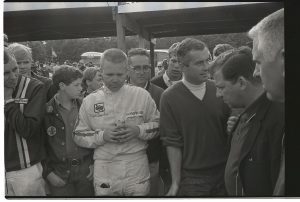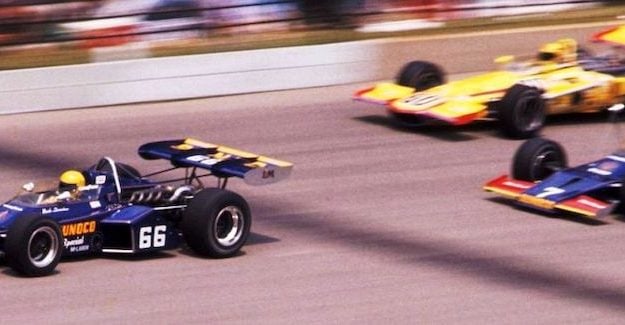On Aug. 9, 1975, Donohue drove a Porsche 917-30 to a world closed-course speed record at Talladega (Ala.) Superspeedway, averaging 221.120 mph around the 2.66-mile track. Donohue held the speed record for 11 years, until it was broken by four-time Indy 500 winner Rick Mears at Michigan Int’l Speedway.
Donohue retired from driving at the end of 1973 with little else to prove. Some felt the decision was fueled by the death of Swede Savage in that year’s Indianapolis 500.
Donohue suffered additional loss when Peter Revson died following a crash while testing a Formula 1 car prior to the 1974 South African Grand Prix. Penske was going Formula 1 racing in 1975 and Revson was to be his driver.

Donohue was lured back to full-time competition to drive for Penske’s Formula 1 team — Penske Cars Ltd. There were two races in 1974 with plans to continue competing in 1975 with the new Penske PC1. Donohue placed12th in the Canadian Grand Prix, but failed to finish in the United States Grand Prix.
The 1975 Formula 1 season got off to a rocky start, as chassis issues plagued the Penske team at every turn. Donohue logged fifth-place finishes in the Swedish Grand Prix and British Grand Prix but did not finish three of the first six races.
Donohue was involved in a violent crash during practice for the Austrian Grand Prix. Reportedly, a flat left-front tire sent Donohue’s March 751 into the catch fencing at 160 mph. A track marshal was killed and another seriously injured by debris from the accident, but Donohue did not appear to be badly injured.
Even though awake and alert, Donohue was rushed to a nearby hospital where he complained of severe headaches. A three-hour surgery was performed to remove a cerebral hemorrhage, but the driver never regained consciousness.
Walter Czarnecki, vice president of Penske Corp. and vice chairman of Team Penske, was the manager of Penske’s American Motor Racing program when he first met Donohue during the late 1960s.
“He was a very thoughtful person and thought about what he said before he said it,” Czarnecki recalled. “He would express himself well, there was no question. There would be times you’d be talking to him and be would be deep in thought about something else, probably something to make a car go faster. He also loved to play practical jokes. He was soft spoken with an easy smile.”
When asked what made Donohue such a versatile racer, Czarnecki said, “I think it was a combination of a lot of things. It was his desire to be a perfectionist and given his engineering background, he really understood what made a car go fast.
“He didn’t just get in, stand on the gas and turn left or right. He understood what made the car go fast and what the car needed to do to go fast and worked intensely to perfect that. He spent so much time testing on the skid pad, so much time just thinking and contemplating. He had the ability to jump in any kind of car and be competitive and win in it.
“Mark really thought everything through and was not afraid to put in the time to develop his concepts, work on the car himself and then go out and test it and compete,” Czarnecki continued. “He knew the limits of the car and drove to the limits all the time.”
It was easy to see how humble Donohue felt about himself and his ability as a racer.
“I enjoy being a driver. I wouldn’t be doing it if I didn’t like it,” Donohue said in the late 1960s documentary “Four Hands on the Wheel” produced by Triangle Film Productions and narrated by Chris Economaki. “You have to spend the time and the effort that’s required. On the other hand, it’s tremendously taxing because your job is on the line every time you get behind the wheel. If there’s somebody else that a guy can hire that’s quicker, then a guy is foolish not to hire him if he could.
“So every time you go to work, basically your job is being evaluated. That doesn’t happen in everyday life. If a guy is left on his own, his abilities will eventually fall down,” Donohue continued. “Having to face this every time you go is a little excruciating as far as your mental approach is concerned.
“Some people, it doesn’t bother them. I think people like Mario Andretti, Bobby Unser perhaps and Al Unser, maybe and some of those folks that have been racing for a long time and are accepted experts that drive anything who really don’t know anything else, except driving. They can pretty much not worry about that sort of thing.
“My position, I don’t think I’m as good a driver as I am capable of maybe getting the best car together.”
His success story in auto racing is fascinating albeit far too short as has been the case with many racing legends.
This story appeared in the Jan. 11 edition of the SPEED SPORT Insider.

